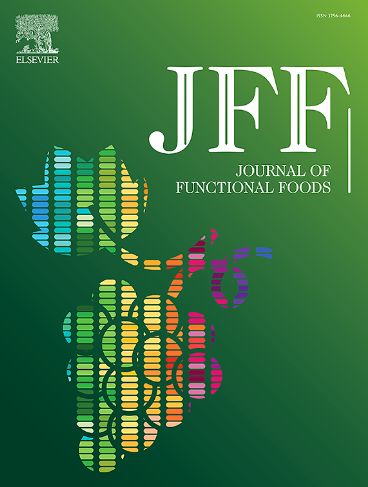Protective role of bee pollen-enriched soy milk in enhancing renal function and alleviating nephrotoxicity
IF 4
2区 农林科学
Q2 FOOD SCIENCE & TECHNOLOGY
引用次数: 0
Abstract
This study investigates the protective effects of soy milk fortified with Bee Pollen (SMBP) against renal damage in a rat model. The rats were divided into four groups: control, SMBP-treated, cisplatin-treated, and cisplatin + SMBP co-treated. Kidney function was assessed by measuring serum urea, creatinine, and uric acid levels. Oxidative stress was evaluated through malondialdehyde (MDA) levels, and antioxidant enzyme activities (GSH, SOD, and CAT) were measured. Inflammatory and apoptotic markers (NF-κB, IL-8, TNF-α, caspase-3, and caspase-9) were also analyzed, along with histopathological changes and immunohistochemical expression of NF-κB and cytochrome C. The results showed that adding 1 %, 3 %, and 5 % bee pollen to soy milk significantly increased protein content from 3.85 % in the control group to 9.26 % in the 5 % bee pollen sample. Bee pollen concentrations also enhanced antioxidant activity, total solids, and phenolic and flavonoid levels. Cisplatin treatment caused significant renal dysfunction, oxidative stress, elevated inflammatory markers, and apoptosis, accompanied by histopathological changes. Co-treatment with SMBP significantly reduced these effects, improving kidney function, reducing oxidative stress, and lowering inflammation and apoptosis. Histological analysis showed restored kidney architecture. These findings suggest that SMBP has strong nephroprotective properties, effectively counteracting renal damage through antioxidant, anti-inflammatory, and anti-apoptotic mechanisms.

蜂花粉豆浆增强肾功能和减轻肾毒性的保护作用
本研究探讨了蜂花粉强化豆浆(SMBP)对大鼠肾损伤的保护作用。将大鼠分为4组:对照组、SMBP组、顺铂组、顺铂+ SMBP组。通过测定血清尿素、肌酐和尿酸水平来评估肾功能。通过丙二醛(MDA)水平评估氧化应激,并测定抗氧化酶活性(GSH、SOD和CAT)。分析炎症和凋亡标志物(NF-κB、IL-8、TNF-α、caspase-3、caspase-9)以及组织病理学变化和NF-κB、细胞色素c的免疫组化表达。结果表明,在豆浆中添加1%、3%和5%的蜂花粉可显著提高豆浆中蛋白质含量,从对照组的3.85%提高到5%蜂花粉样品的9.26%。蜂花粉浓度还能提高抗氧化活性、总固形物、酚类和类黄酮含量。顺铂治疗引起明显的肾功能障碍、氧化应激、炎症标志物升高和细胞凋亡,并伴有组织病理学改变。与SMBP联合治疗可显著降低这些影响,改善肾功能,减少氧化应激,降低炎症和细胞凋亡。组织学分析显示肾脏结构恢复。这些发现表明SMBP具有很强的肾保护作用,通过抗氧化、抗炎和抗凋亡机制有效对抗肾损伤。
本文章由计算机程序翻译,如有差异,请以英文原文为准。
求助全文
约1分钟内获得全文
求助全文
来源期刊

Journal of Functional Foods
FOOD SCIENCE & TECHNOLOGY-
CiteScore
9.60
自引率
1.80%
发文量
428
审稿时长
76 days
期刊介绍:
Journal of Functional Foods continues with the same aims and scope, editorial team, submission system and rigorous peer review. We give authors the possibility to publish their top-quality papers in a well-established leading journal in the food and nutrition fields. The Journal will keep its rigorous criteria to screen high impact research addressing relevant scientific topics and performed by sound methodologies.
The Journal of Functional Foods aims to bring together the results of fundamental and applied research into healthy foods and biologically active food ingredients.
The Journal is centered in the specific area at the boundaries among food technology, nutrition and health welcoming papers having a good interdisciplinary approach. The Journal will cover the fields of plant bioactives; dietary fibre, probiotics; functional lipids; bioactive peptides; vitamins, minerals and botanicals and other dietary supplements. Nutritional and technological aspects related to the development of functional foods and beverages are of core interest to the journal. Experimental works dealing with food digestion, bioavailability of food bioactives and on the mechanisms by which foods and their components are able to modulate physiological parameters connected with disease prevention are of particular interest as well as those dealing with personalized nutrition and nutritional needs in pathological subjects.
 求助内容:
求助内容: 应助结果提醒方式:
应助结果提醒方式:


